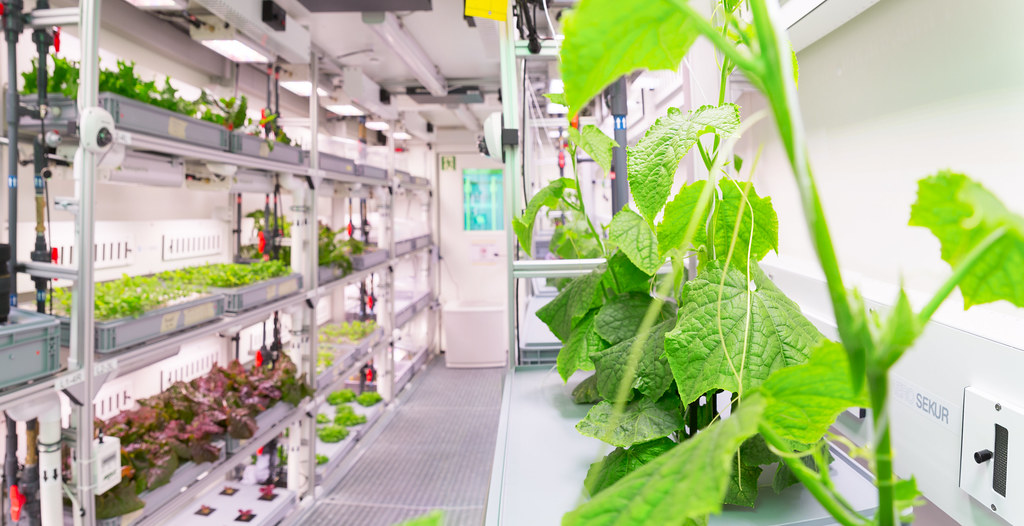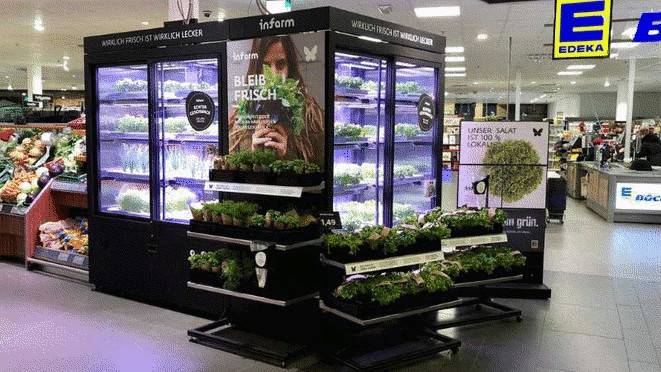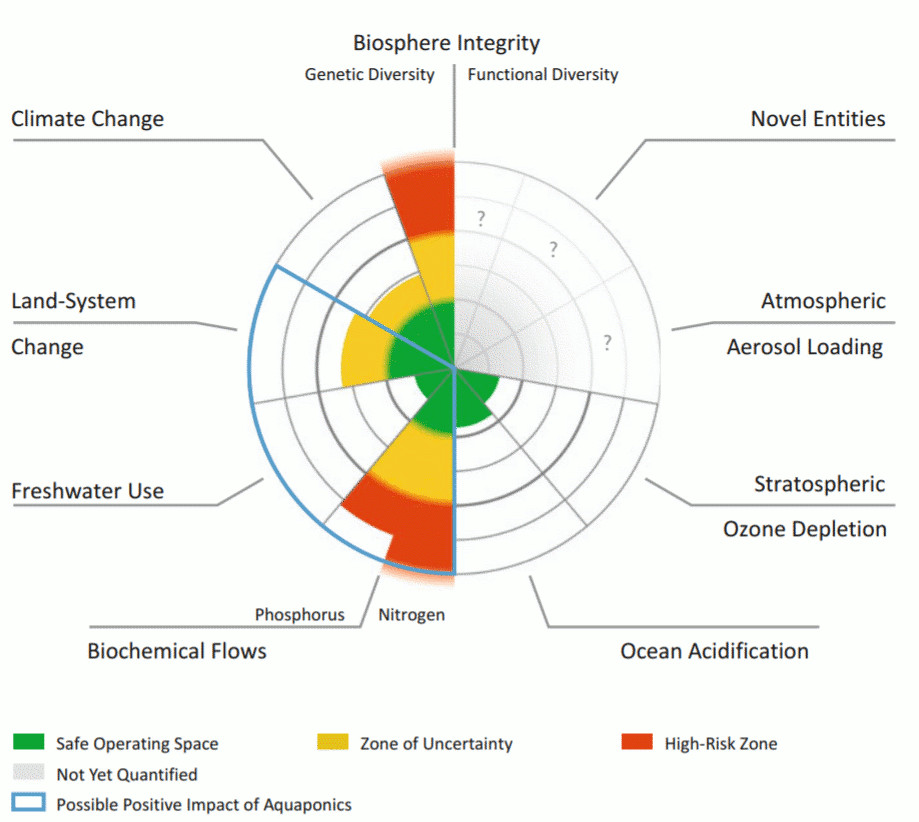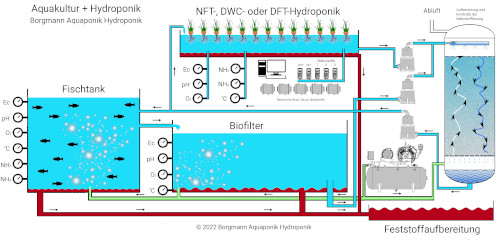Aquaponics: Sustainable Food Production in a Cycle
Aquaponics is a method that combines the rearing of fish in aquaculture with the cultivation of plants in hydroponics. There are different approaches to deliver the nutrients produced by the fish to the plants.

Aquaponics, like hydroponics systems, are always part of a closed cycle. Aquaponics, for fish production, always contains a hydroponic system for plant cultivation. The system works by using the waste from fish farming as nutrients for the plants.
Automated Nutrient Supply
This happens automatically in our systems via dosing systems. Through appropriate control of nutrient supply - optimized for the selected plant species and its growth phase. The closed cycle results in well over 90% of the necessary nutrients, i.e., the investments, actually being contained in the two end products (vegetables & fish).
Advantages over Soil-Based Cultivation
High Efficiency
- High Yield: 500m² yields up to 8 tons of fish and 16 tons of tomatoes per year
- Minimal Space Requirement: Profitability from 500 m²
- Weather Independence: Year-round operation and yield
Environmental Friendliness
- Independence from Rainfall: closed cycle
- Very low water consumption
- No use of pesticides, herbicides, or medication
- No groundwater contamination
Automated System Control
We offer control systems for the automated management of your aquaponics and hydroponics systems. Our range extends from systems solely for documentation to fully autonomous system control.
Aquaponics and Hydroponics: Situation, Market Demand and Development
Food production depends on the availability of resources such as land, freshwater, fossil energy, and nutrients (Conijn et al. 2018), and the current consumption or depletion of these resources exceeds their global regeneration rate (Van Vuuren et al. 2010).
Planetary Boundaries
The concept of planetary boundaries aims to define the ecological limits within which humanity can operate in terms of finite and partly scarce resources (Rockström et al. 2009).
Biochemical flow boundaries that limit food supply are stricter than climate change (Steffen et al. 2015).
Sustainable Development through Aquaponics
Aquaponics (Aquaculture + Hydroponics) has been identified as an agricultural approach that can contribute to achieving both planetary boundaries and sustainable development goals through nutrient and waste recycling, especially in arid regions or areas with non-arable land (Goddek and Körner 2019; Appelbaum and Kotzen 2016; Kotzen and Appelbaum 2010).
Traditional Systems
Traditional single-loop aquaponics system designs include both aquaculture and hydroponic units between which water circulates. In such traditional systems, it is necessary to compromise on the conditions for the two subsystems regarding pH, temperature, and nutrient concentration.
Decoupled Systems
A decoupled aquaponics system can reduce the need for compromise by separating the components, allowing conditions in each sub-system to be optimized.
Urban Food Production
Aquaponics is also seen as a solution for utilizing marginal yield areas in urban settings for food production close to the market.
The issue of complex transportation (From the region for the region) is increasingly becoming an environmental and cost problem in cities.

Hydroponics system in an Edeka supermarket (Infarm / Berlin)
Water Saving through Aquaponics
According to the World Wide Fund for Nature (WWF), about 70 percent of global freshwater consumption is attributed to agriculture and processing. In contrast, aquaponics enables food production with a 50 to 90 percent reduced water consumption.
- 50 percent saving in single-loop systems
- 90 percent saving in dual-loop systems with water recovery
Available Resources for Nutrition

Planetary boundaries according to Steffen et al. (2015)
Resource Scarcity Requires Rethinking
Due to the resource situation, a rethink in food supply is inevitable. The green zone is the safe operating space, the yellow zone represents the zone of uncertainty (increasing risk), the red zone is a high-risk zone.
The blue-outlined variables (i.e., land-system change, freshwater use, and biochemical flows) indicate the planetary boundaries on which aquaponics can have a positive influence.
Further Information and Figures
What is Aquaponics: BR Contribution
To the VideoFertilizer Use
In German agriculture, the limit of 200 tons per hectare per year has already been exceeded.
SourceYields in Organic Farming
View StudyCost Accounting in Crop Production
DatabaseYields in Aquaponics
Watch VideoLiterature and References
Appelbaum S, Kotzen B (2016) Further investigations of aquaponics using brackish water resources of the Negev desert. Ecocycles 2:26. https://doi.org/10.19040/ecocycles.v2i2.53
Bernstein S (2011) Aquaponic gardening: a step-by-step guide to raising vegetables and fish together. New Society Publishers, Gabriola Island
Conijn JG, Bindraban PS, Schröder JJ, Jongschaap REE (2018) Can our global food system meet food demand within planetary boundaries? Agric Ecosyst Environ 251:244–256. https://doi.org/10.1016/J.AGEE.2017.06.001
Ehrlich PR, Harte J (2015) Opinion: to feed the world in 2050 will require a global revolution. Proc Natl Acad Sci U S A 112:14743–14744. https://doi.org/10.1073/pnas.1519841112
Goddek S (2017) Opportunities and challenges of multi-loop aquaponic systems. Wageningen University, Wageningen. https://doi.org/10.18174/412236
Goddek S, Keesman KJ (2018) The necessity of desalination technology for designing and sizing multi-loop aquaponics systems. Desalination 428:76–85. https://doi.org/10.1016/j.desal.2017.11.024
Goddek S, Körner O (2019) A fully integrated simulation model of multi-loop aquaponics: a case study for system sizing in different environments. Agric Syst 171:143–154. https://doi.org/10.1016/j.agsy.2019.01.010
Kotzen B, Appelbaum S (2010) An investigation of aquaponics using brackish water resources in the Negev desert. J Appl Aquac 22:297–320. https://doi.org/10.1080/10454438.2010.527571
Manelli A (2016) New paradigms for a sustainable Well-being. Agric Agric Sci Procedia 8:617–627. https://doi.org/10.1016/J.AASPRO.2016.02.084
Steffen W, Richardson K, Rockström J, Cornell SE, Fetzer I, Bennett EM, Biggs R, Carpenter SR, de Vries W, de Wit CA, Folke C, Gerten D, Heinke J, Mace GM, Persson LM, Ramanathan V, Reyers B, Sörlin S (2015) Planetary boundaries: guiding human development on a changing planet. Science 347(80):736
BUND Glyphosate Study: https://www.bund.net/fileadmin/user_upload_bund/publikationen/umweltgifte/glyphosat_urin_hintergrund.pdf
Data Bridge Market Research: https://www.databridgemarketresearch.com/reports/global-aquaponics-market
Aquaponics Market Share Trends 2022: https://badenwurttembergzeitung.com/2022/04/03/aquaponik-marktanteilstrends-2022-globale-wachstumsherausforderungen-chancen-und-regionale-segmentierungsprognose-bis-2024/
Fertilizer Prices: https://www.agrarheute.com/markt/duengemittel/duengerpreise-steigen-extrem-hoch-kommt-noch-schlimmer-582641
Kontext:




Add Comment